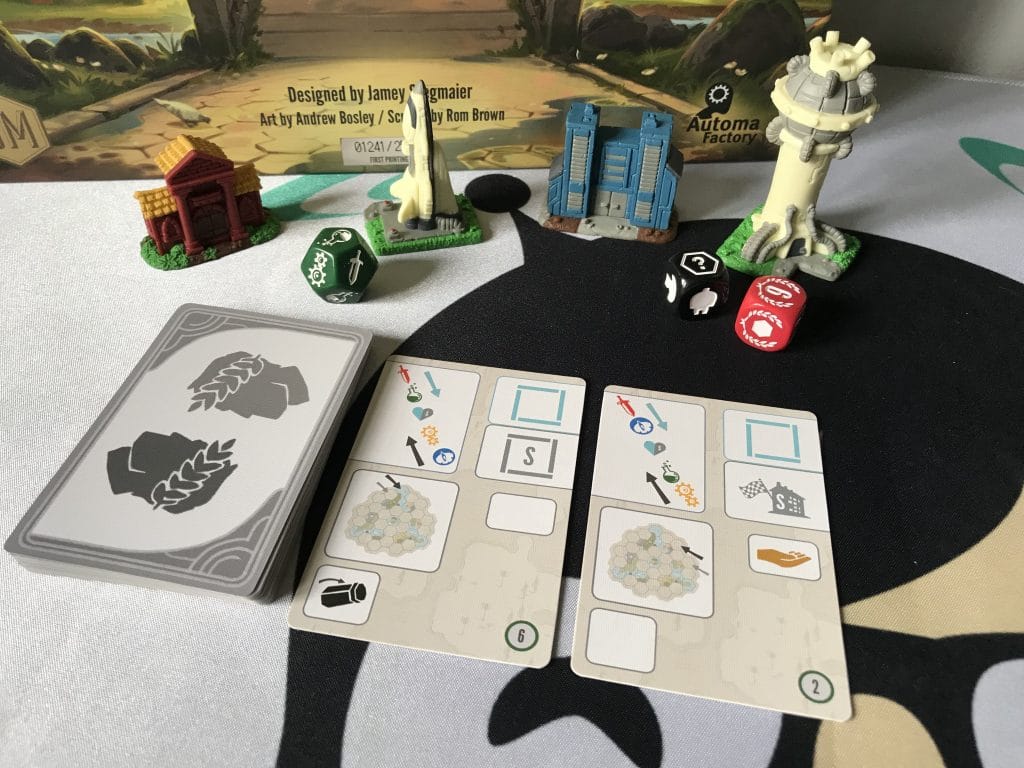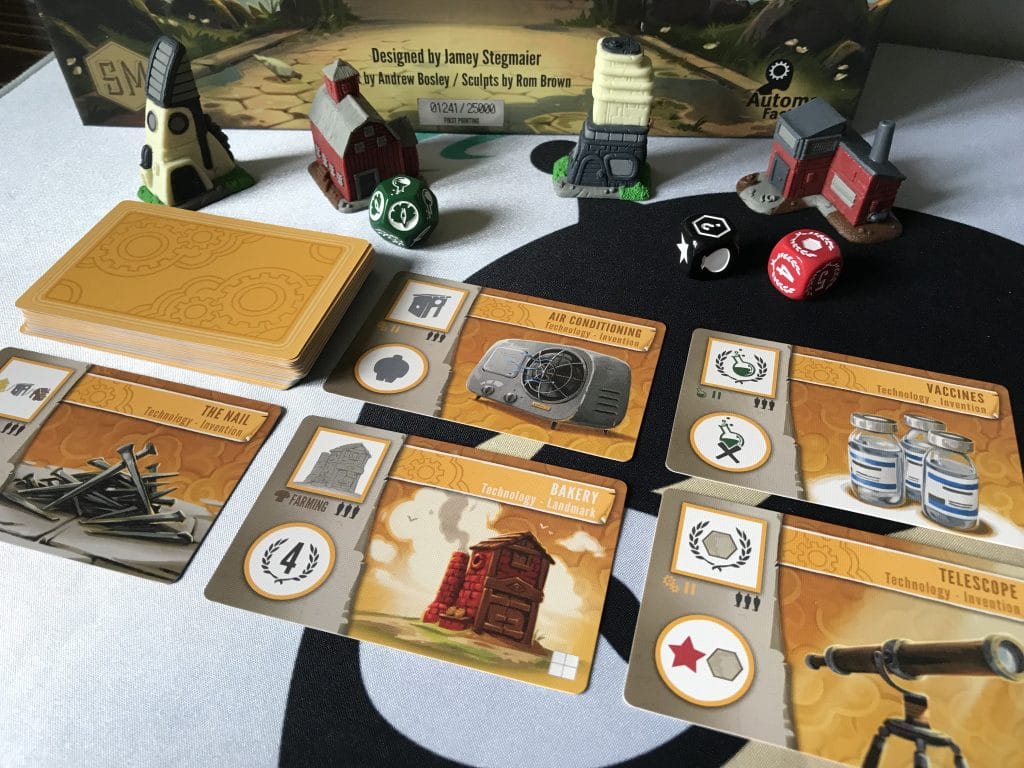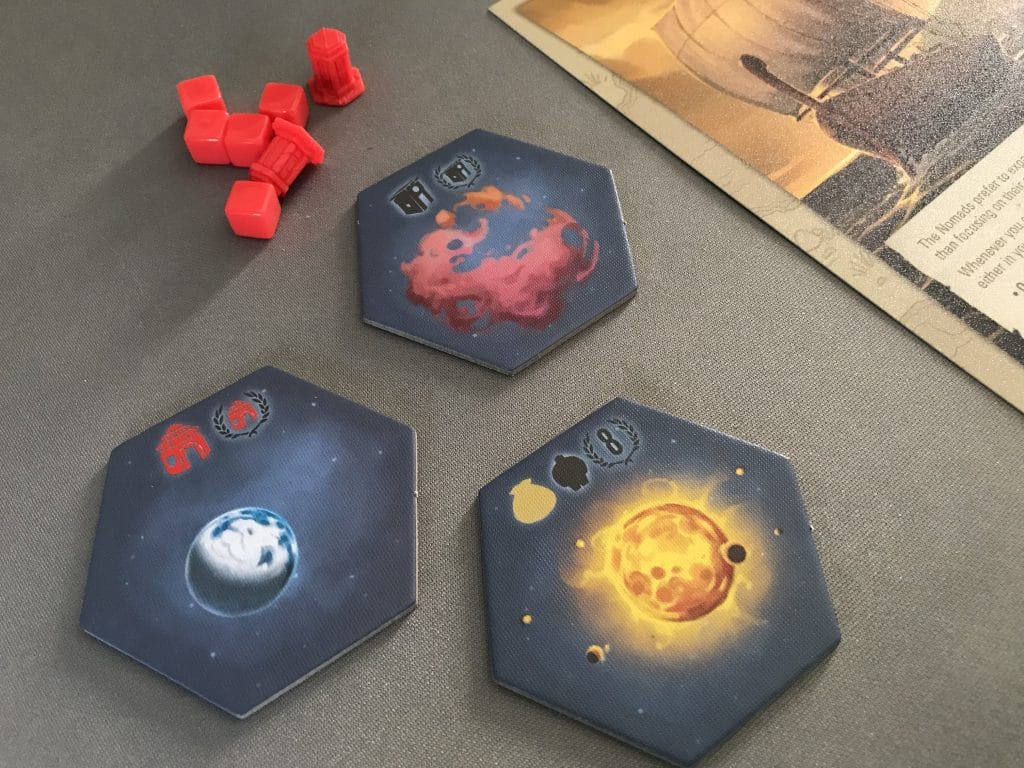Age of Empires used to be all the rage. I remember watching my friend build up their medieval civilization, dreaming that one day I’d be able to get a copy and do the same. Eventually, we picked up a copy of Age of Mythology II and a year of my life flew by.
When I think about civilization games, I picture the technology trees that need to be unlocked before advancing to the next era. Wow – now my soldiers can use iron arrows and I can establish trade routes! These games are always about starting from nothing and building up into a memorable blip on the annals of history.
When details of Tapestry began trickling out, I was on the hook for several reasons.
- First, it’s already well-known that I enjoy playing quite a few titles published by Stonemaier Games (i.e. Viticulture, Scythe, Wingspan).
- Secondly, I was intrigued by the civilization theme, with the full understanding that it wasn’t going to fit inside the generally accepted requirements of a civilization game.
- Plus, the art does wonders to draw me in.
How does it stack up to the others Stonemaier titles? Let’s find out!
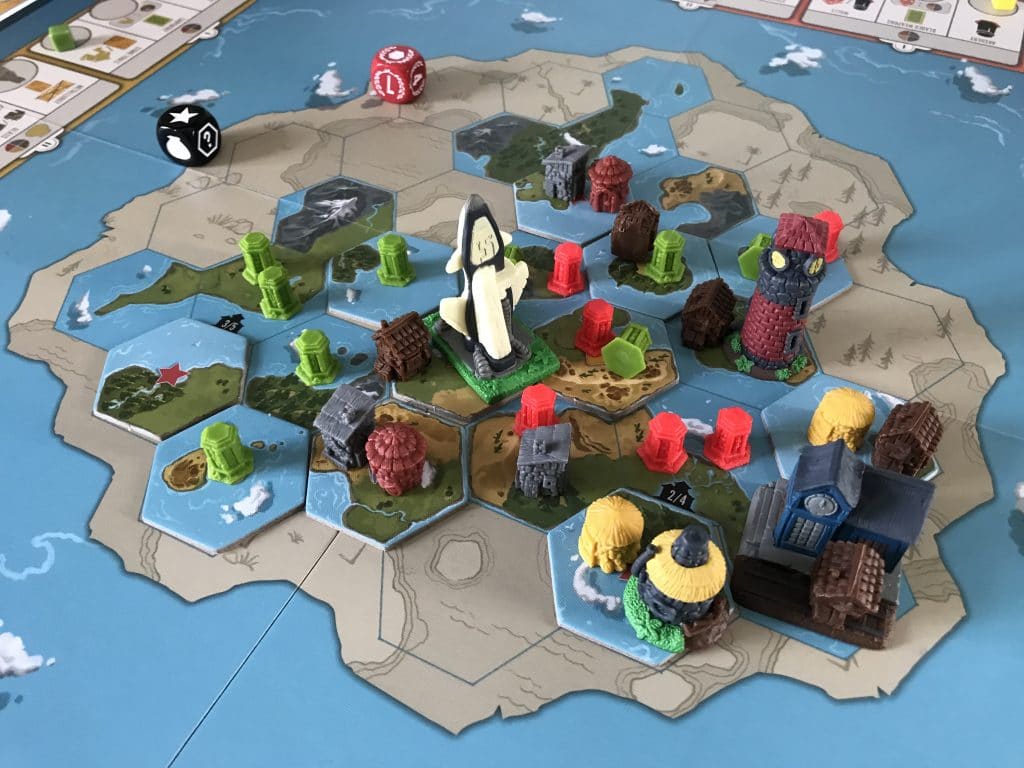
Tapestry: A Civilization Game
When people say ‘civilization game’, they’re generally referring to games that follow the 4X model: explore, expand, exploit, and exterminate. Purists believe that if a game doesn’t fit this framework, then it shouldn’t be in the same conversation as something like Sid Meier’s Civilization or the acclaimed board game, Through the Ages.
However, I’m in the camp that believes that a 4X game is just a subset of the greater category of civilization games. To me, a civilization game only needs three things:
- Progression of technology over time that provides players with an opportunity to set goals
- Unique empires that interact with other players, usually through diplomacy or combat
- Ways to explore and uncover details of a shared world map
Tapestry checks all of these boxes. It may not fit the de facto mold of the gaming community’s definition of a civilization game, but it certainly fits mine. It’s not like Stonemaier was trying to hoodwink anybody either; there was an abundance of preview material prior to the game’s release that showed exactly how the game played and the kind of game that it is.
Tapestry: Makers of Fire
All pedantry aside, let’s talk about how the game works. To start a game of Tapestry, players receive a civilization card that outlines their unique qualities. For example, you might have Militants that specialize in conquering other tiles, or Inventors that handle technology better than the others.
Players take turns paying resources and progressing down one of the game’s four tracks: Technology, Science, Military, or Exploration. As you can imagine, the benefits of each track get increasingly better at a slightly higher cost as you progress.
- Technology allows you to gain tech cards, which can be upgraded to grant beneficial effects
- Science centers around a science die, helping you move up other tracks but usually at the cost of the current benefit of those tracks
- Military is all about placing outposts on other tiles, and toppling the tiles of your opponents
- Exploration focuses on the acquisition of terrain tiles that you place to form the map, allowing different areas to expand to.
If you’re the first player to enter into the next era of a specific track, you also gain a landmark. These painted sculpts are the visual bread-and-butter of the game. You use them, along with income buildings, to fill out your civilization’s capital city map. Apart from that, they don’t unlock any additional bonuses.
Once you run out of resources, or if you want to gain a nice little bonus, you can choose to advance to the next era. This is where the engine-building elements come into play, and each civilization begins to evolve.
Players will add a tapestry card (hey – that’s the name of the game!), which gives an immediate benefit for that particular era. They also gain income, upgrade tech, and score points based on uncovered spaces of their player mat. Additionally, their civilization may also grant them extra resources or boons when taking an income turn.
Play continues around the table until every player has taken their final income phase. This means that everybody is going to be ending the game at different times, although there usually isn’t much waiting around if you finish first. There’s definitely some nuance to the timing of taking income versus maximizing your position each era.
There’s a lot of iconography in the game, so over the first couple plays you’ll likely find yourself referencing the 4-page rulebook or the double-sided reference page. Once you get the hang of the nomenclature, the icons become relatively intuitive.
Overall, the game plays really well. I always find myself wanting to advance on multiple tracks, which is a good ‘problem’ for a game to have. It can be swingy at times and there are some interactions between tapestry cards and civilizations that require some extra finagling to interpret the results of what’s supposed to happen. With so many iterations of cards, however, that’s expected to happen with some level of frequency.
Staking Our C.L.A.I.M on Tapestry
 Components
Components
Jamey Stegmaier, the designer of Tapestry, mentioned that the main inspiration for the game came from the beautiful landmarks miniatures sculpted by Rom Brown. They are the stars of the show and the belles of the ball! These things are wonderful, and feel great when you gain them and take up a huge chunk of space on your capital city map. Plus there’s a nice storage tray to keep them all snug and secured.
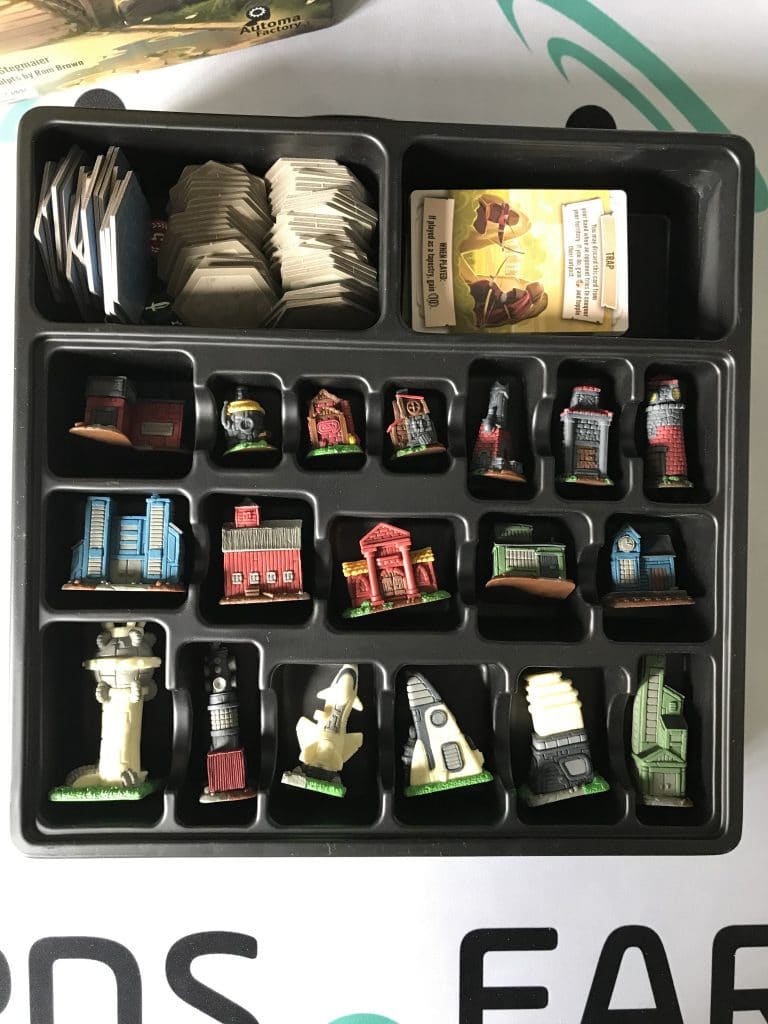
Everything else is high-quality, as to be expected from Stonemaier Games. The player tokens and incomes buildings have a superb tactile feel, especially against the raised graininess of the player mats. Having that extra texture doesn’t seem like much, but it feels very unique to Tapestry.
There really isn’t much else to say here. Stonemaier has consistently delivered top-quality components and they went all out with this one.
My only qualm is with the durability of the civilization mats and capital city mats. If you are randomly shuffling these up prior to setup, the edges are going to get a little dinged up over time. It’s a small price to pay, but if you take some care in handling them you’ll prolong their longevity.
You’re also getting three custom dice – two six-sided dice for conquest actions and one dodecahedron for the science track. They’re well-made and will hold up well to constant chucking across the table.
 Luck
Luck
Luck plays a definitive role in Tapestry, starting all the way in the game’s setup. Depending on your civilization draw, you may find yourself facing down a difficult path that forces you to change your initial strategy. Because of the varying abilities that each civilization has, there are bound to be some balance issues from game to game.
The good news is that people have been reporting certain civilizations as being over-powered or under-powered, and I’ve seen the same ones mentioned on both lists. This likely means that there is some situational bias being injected into the comments, and the game might be more balanced than it initially appears.
Take the Futurists, for example. They allow a player to start the game four spaces up on every track. When I first read that, I almost wanted to rip the civilization mat in half. That seems absolutely bonkers!
Further reflection, however, reveals that the Futurist player has to use their resources wisely. Since they’re starting in the second tier of each track, each of their actions require double the resources of the other players. They’re also missing out on some valuable income buildings in the earlier spaces.
You’ll also see luck in the draw of the technology cards and the tapestry cards. With the tech cards, luck is mitigated by being able to have three cards to choose from, plus the ability to take a random one if nothing suits your fancy. Each player is also only playing about three tapestry cards per game, and you’ll usually have a couple to choose from each income turn.
 Aesthetics
Aesthetics
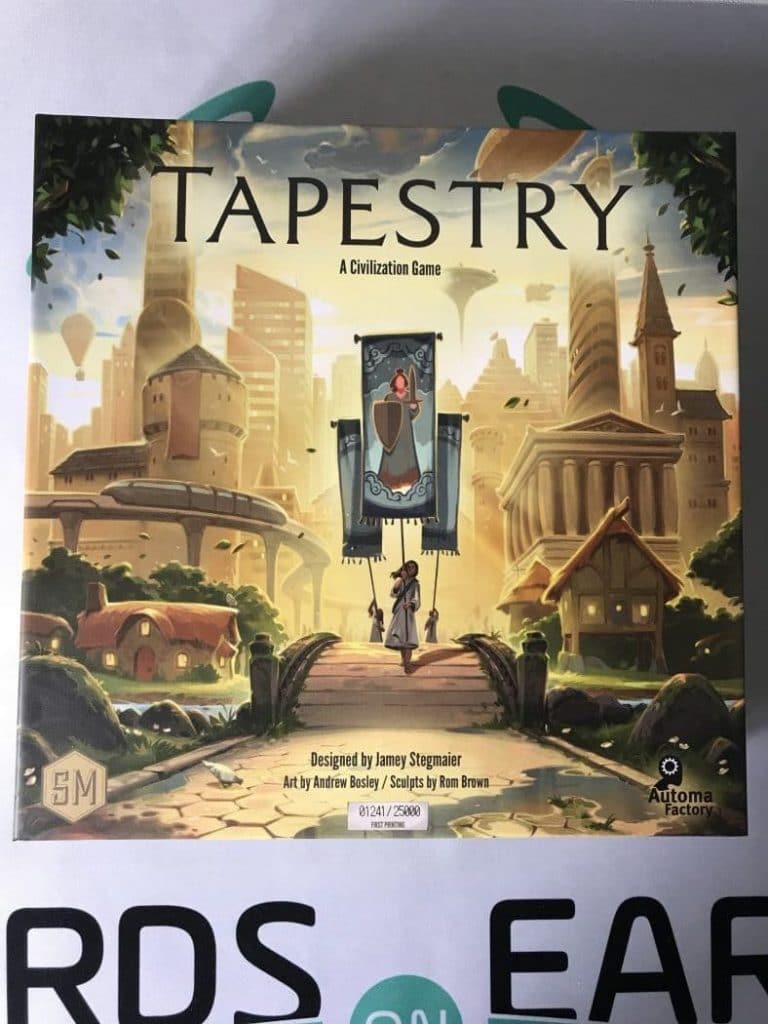
As I mentioned earlier, I am easily swayed by gorgeous art and schnazzy components. When it comes to thematic games, I want to experience the mechanics with the art and vice versa. Tapestry is presented with a cohesive art-style that even includes some easter egg nods to other Stonemaier titles.
The only part of the game that doesn’t seem to follow the same visual theme as the rest is the game board. For whatever reason, the light blue highlight seems to take me out of the moment a little bit; that color choice almost seems to ‘gameify’ the game, if that makes sense. Everything else – the tech cards, tapestry cards, player mats, buildings – they all mesh really well together. There’s just something about the board that throws me for a loop.
Again, I’m nitpicking here. The box draws you in immediately, and the civilization mats are cleverly designed from an artistic standpoint. It’s really great; you can tell that care went into the entire process.
![]()
Space Exploration Tiles 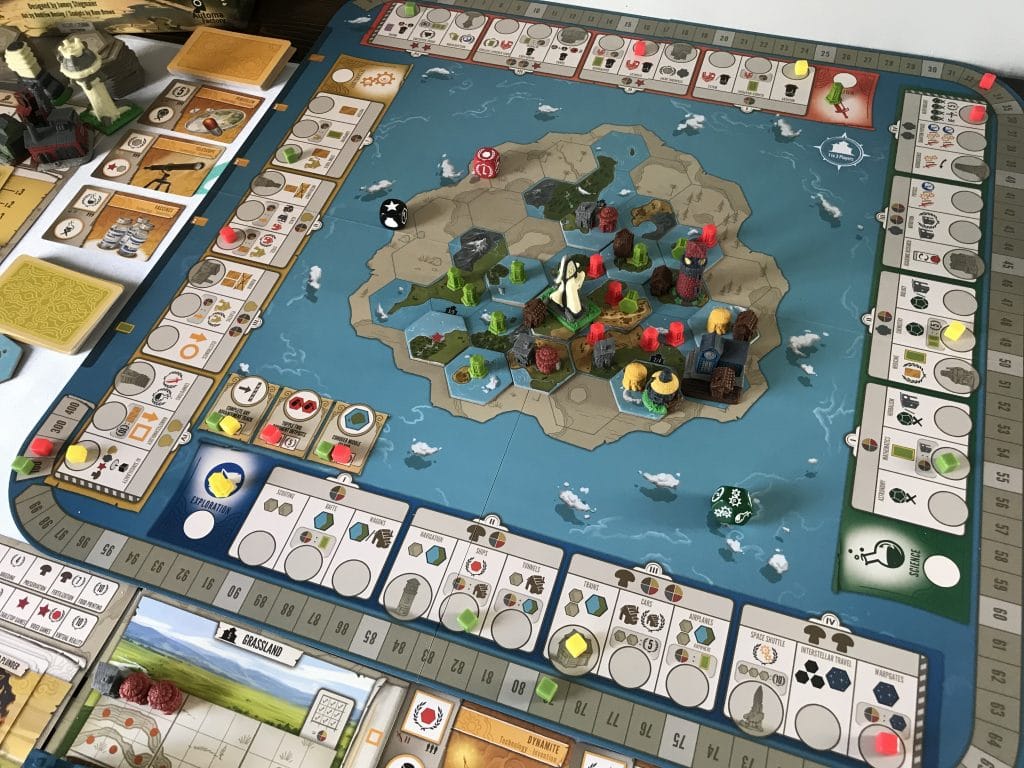
Large Game Board
 Interest
Interest
In my exposé above, I relayed my thoughts about Tapestry being labeled as a civilization game. However, it doesn’t necessarily fit the ‘traditional’ civilization criteria.
People looking for the next Gaia Project, Twilight Imperium, or Terra Mystica should probably pump the brakes a bit. That’s not to say they won’t like Tapestry, but their expectations should be curbed that this is a different kind of civilization game.
What I really like about Tapestry is that you’re always weighing several choices. Do I go up on the Science track and push my luck that I’ll roll to move up on the Military track? But if I do that, I’m going to lose traction on the Exploration track and likely miss out on that landmark! And I still need a tech card before my next income phase.
I’d also like to mention that the solo game is exceptional. Instead of playing against a single AI (Automa), you are competing against the Automa and a Shadow Empire. Only the Automa gains points but the Shadow Empire competes for landmarks, making it extra important to manage your position on the tracks accordingly.
 Mood
Mood
While placing buildings on your capital city map, playing tapestry cards, and upgrading your technology, you can see your civilization shaping in front of your eyes. I’ll admit – the thematic experience isn’t as immersive as it could be. If the landmarks provided mechanical benefits, that would be an improvement in this area.
That being said, there’s still a lot of talk at the table about the interesting civilization abilities. You can definitely see the synergies between the civilizations and their tracks of expertise.
Tapestry is a game where players are starting out on their own little islands, unaware of the others’ existences. As the game goes on, you begin interacting with the rest of the world, either through exploration, conquest, or technology.
Tapestry: One for the Ages!
There was a ton of hype for Tapestry when it was announced; it was a daily trickle of new information that kept everyone’s attention. From a marketing standpoint, it was a smart way to generate buzz for a new product and limit the amount of waiting time between announcement and release.
Tapestry gets the Nerds on Earth Seal of Awesomeness. I’ve loved every play and how multiple strategies are viable for victory. Put another one up in the ‘win’ category for Stonemaier Games – they have another hit on their hands!
Turn fire into time travel with Tapestry!
You can get the Tapestry board game here, direct via Stonemaier Games, or, better yet, ask for it at your Friendly Local Game Shop (FLGS).
[Disclosure: Nerds on Earth was provided a copy of Tapestry by Stonemaier Games in exchange for an honest review.]



